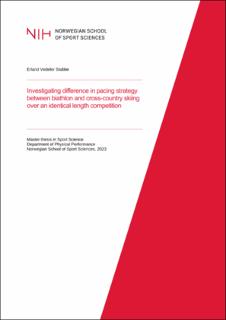| dc.description.abstract | Purpose: Biathlon and cross-country skiing are 2 seemingly similar disciplines, but the prospect of shooting might affect the pacing of biathletes and their skiing performance. Therefore, the aim of this thesis was to investigate if there were differences in pacing strategy over an identical length competition between biathlon and cross-country skiing.
Methods: 52 junior athletes (n=28 males, ⁓ 17yrs), hereby biathletes (n=24, 9 females & 15 males) and cross-country skiers (n=27, 14females & 13 males) performed an individual 6 km (3x2.0km for females) or 7.5 km (3x2.5km for males) simulated competition. For biathletes prone shooting was done after first and second lap, while cross-country skiers skied continuously. Shooting was done on paper targets with 10-point standard rings.
Results: Male biathletes were slower on the first lap and in total course time compared to male cross-country skiers (21sec lap1, 42sec total P<0.05). No difference in course time were found for females (P>0.05). Male biathletes used an even pacing strategy, while male cross-country skiers applied a positive pacing strategy (33.0% vs 32.4% relative to total course time for lap 1 P<0.001, 33.6% vs 34% relative to total course time for lap 2 P<0.01). No difference in pacing strategy between females were observed (P>0.05). Both male and female biathletes reported lower summated rate of perceived exertion (RPE) over the duration of the competition compared to male and female cross-country skiers (136.6 vs 149.2 for female, 139.2 vs 147.5 for males P<0.05). Both sexes reported lower RPE after first shooting compared to second shooting (12 vs 14.9 and 13.2 vs 16.7 for female, 12.3 vs 15.1 and 13.8 vs 16.6 for male, P<0.01). No difference in shooting performance was found between the shootings.
Conclusion: Male biathletes showed a more even pacing strategy compared to male cross-country skiers, while female biathletes showed similar pacing strategy as female cross-country skiers but reported lower RPE values. These differences in pacing and RPE alludes to different physical factors affecting skiing performance in biathlon and cross-country skiing, but more research is needed. | en_US |
